HAT304: Medical Tourism in Australia - Touchpoints, Issues, Solutions
VerifiedAdded on 2023/06/09
|12
|1852
|491
Report
AI Summary
This report examines the medical tourism sector in Australia, focusing on the five key touchpoints of travelers: dreaming, planning, booking, experiencing, and sharing. It identifies central issues within each touchpoint, such as economic impacts, globalization, customer perceptions, ethical considerations, and competition. The report also evaluates the effectiveness of current solutions implemented by the Australian hospitality sector and government to address these issues, including investments in infrastructure, promotion, and support for medical organizations and hotels. The analysis concludes that while medical tourism holds significant potential for Australia, continuous efforts to mitigate challenges and enhance traveler experiences are crucial for sustainable growth. Desklib provides access to similar reports and study resources for students.
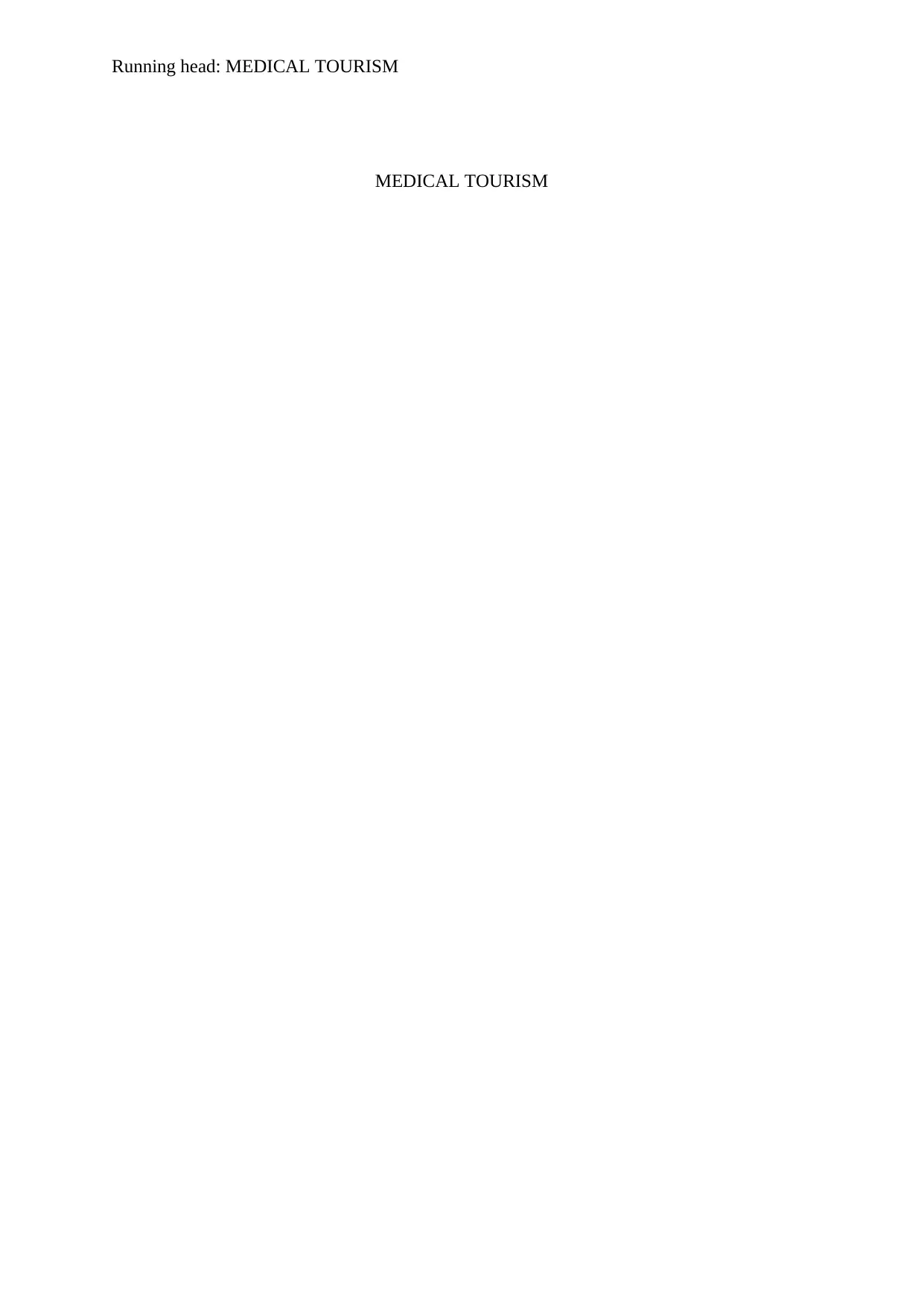
Running head: MEDICAL TOURISM
MEDICAL TOURISM
MEDICAL TOURISM
Paraphrase This Document
Need a fresh take? Get an instant paraphrase of this document with our AI Paraphraser
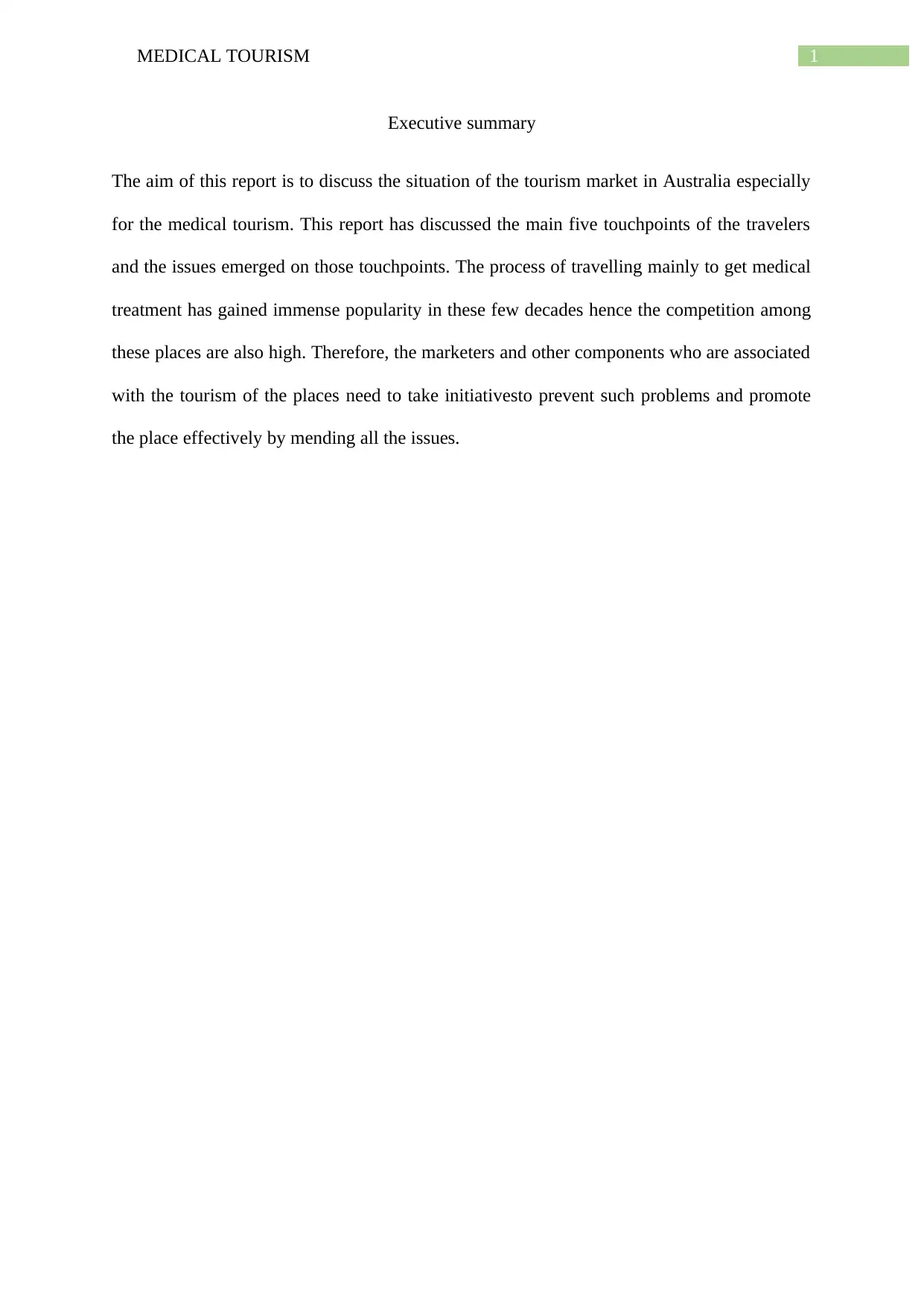
1MEDICAL TOURISM
Executive summary
The aim of this report is to discuss the situation of the tourism market in Australia especially
for the medical tourism. This report has discussed the main five touchpoints of the travelers
and the issues emerged on those touchpoints. The process of travelling mainly to get medical
treatment has gained immense popularity in these few decades hence the competition among
these places are also high. Therefore, the marketers and other components who are associated
with the tourism of the places need to take initiativesto prevent such problems and promote
the place effectively by mending all the issues.
Executive summary
The aim of this report is to discuss the situation of the tourism market in Australia especially
for the medical tourism. This report has discussed the main five touchpoints of the travelers
and the issues emerged on those touchpoints. The process of travelling mainly to get medical
treatment has gained immense popularity in these few decades hence the competition among
these places are also high. Therefore, the marketers and other components who are associated
with the tourism of the places need to take initiativesto prevent such problems and promote
the place effectively by mending all the issues.
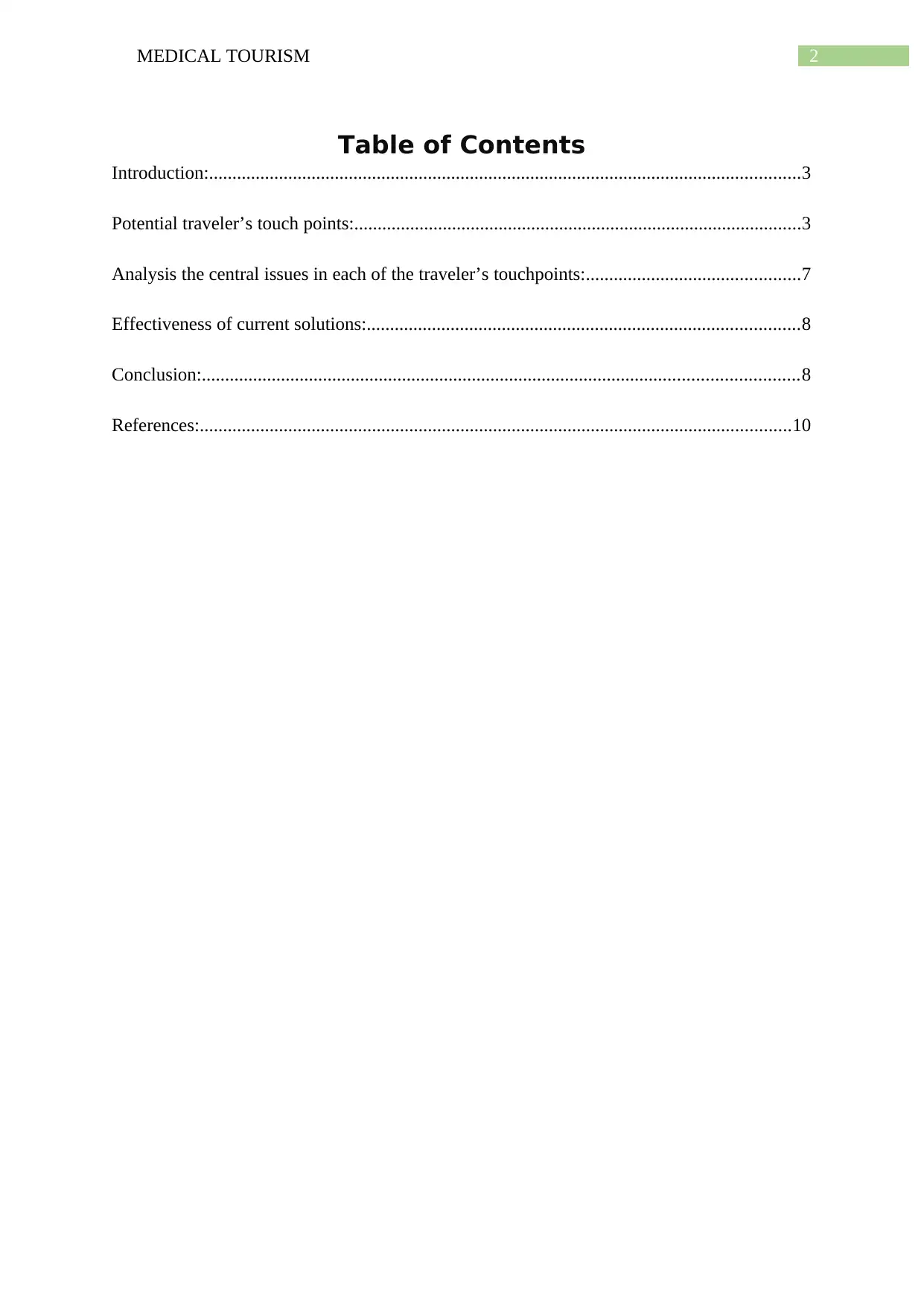
2MEDICAL TOURISM
Table of Contents
Introduction:...............................................................................................................................3
Potential traveler’s touch points:................................................................................................3
Analysis the central issues in each of the traveler’s touchpoints:..............................................7
Effectiveness of current solutions:.............................................................................................8
Conclusion:................................................................................................................................8
References:...............................................................................................................................10
Table of Contents
Introduction:...............................................................................................................................3
Potential traveler’s touch points:................................................................................................3
Analysis the central issues in each of the traveler’s touchpoints:..............................................7
Effectiveness of current solutions:.............................................................................................8
Conclusion:................................................................................................................................8
References:...............................................................................................................................10
⊘ This is a preview!⊘
Do you want full access?
Subscribe today to unlock all pages.

Trusted by 1+ million students worldwide
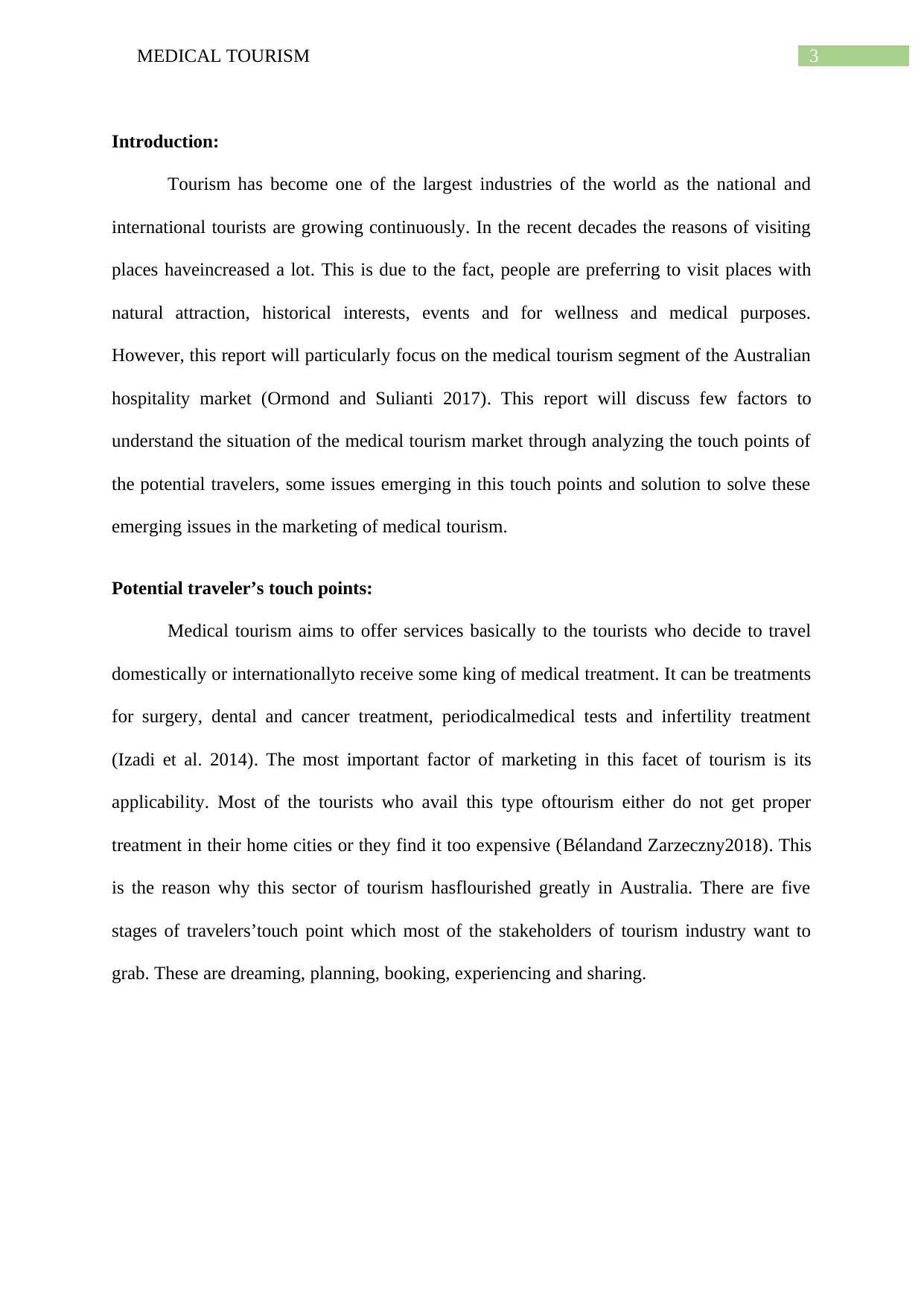
3MEDICAL TOURISM
Introduction:
Tourism has become one of the largest industries of the world as the national and
international tourists are growing continuously. In the recent decades the reasons of visiting
places haveincreased a lot. This is due to the fact, people are preferring to visit places with
natural attraction, historical interests, events and for wellness and medical purposes.
However, this report will particularly focus on the medical tourism segment of the Australian
hospitality market (Ormond and Sulianti 2017). This report will discuss few factors to
understand the situation of the medical tourism market through analyzing the touch points of
the potential travelers, some issues emerging in this touch points and solution to solve these
emerging issues in the marketing of medical tourism.
Potential traveler’s touch points:
Medical tourism aims to offer services basically to the tourists who decide to travel
domestically or internationallyto receive some king of medical treatment. It can be treatments
for surgery, dental and cancer treatment, periodicalmedical tests and infertility treatment
(Izadi et al. 2014). The most important factor of marketing in this facet of tourism is its
applicability. Most of the tourists who avail this type oftourism either do not get proper
treatment in their home cities or they find it too expensive (Bélandand Zarzeczny2018). This
is the reason why this sector of tourism hasflourished greatly in Australia. There are five
stages of travelers’touch point which most of the stakeholders of tourism industry want to
grab. These are dreaming, planning, booking, experiencing and sharing.
Introduction:
Tourism has become one of the largest industries of the world as the national and
international tourists are growing continuously. In the recent decades the reasons of visiting
places haveincreased a lot. This is due to the fact, people are preferring to visit places with
natural attraction, historical interests, events and for wellness and medical purposes.
However, this report will particularly focus on the medical tourism segment of the Australian
hospitality market (Ormond and Sulianti 2017). This report will discuss few factors to
understand the situation of the medical tourism market through analyzing the touch points of
the potential travelers, some issues emerging in this touch points and solution to solve these
emerging issues in the marketing of medical tourism.
Potential traveler’s touch points:
Medical tourism aims to offer services basically to the tourists who decide to travel
domestically or internationallyto receive some king of medical treatment. It can be treatments
for surgery, dental and cancer treatment, periodicalmedical tests and infertility treatment
(Izadi et al. 2014). The most important factor of marketing in this facet of tourism is its
applicability. Most of the tourists who avail this type oftourism either do not get proper
treatment in their home cities or they find it too expensive (Bélandand Zarzeczny2018). This
is the reason why this sector of tourism hasflourished greatly in Australia. There are five
stages of travelers’touch point which most of the stakeholders of tourism industry want to
grab. These are dreaming, planning, booking, experiencing and sharing.
Paraphrase This Document
Need a fresh take? Get an instant paraphrase of this document with our AI Paraphraser
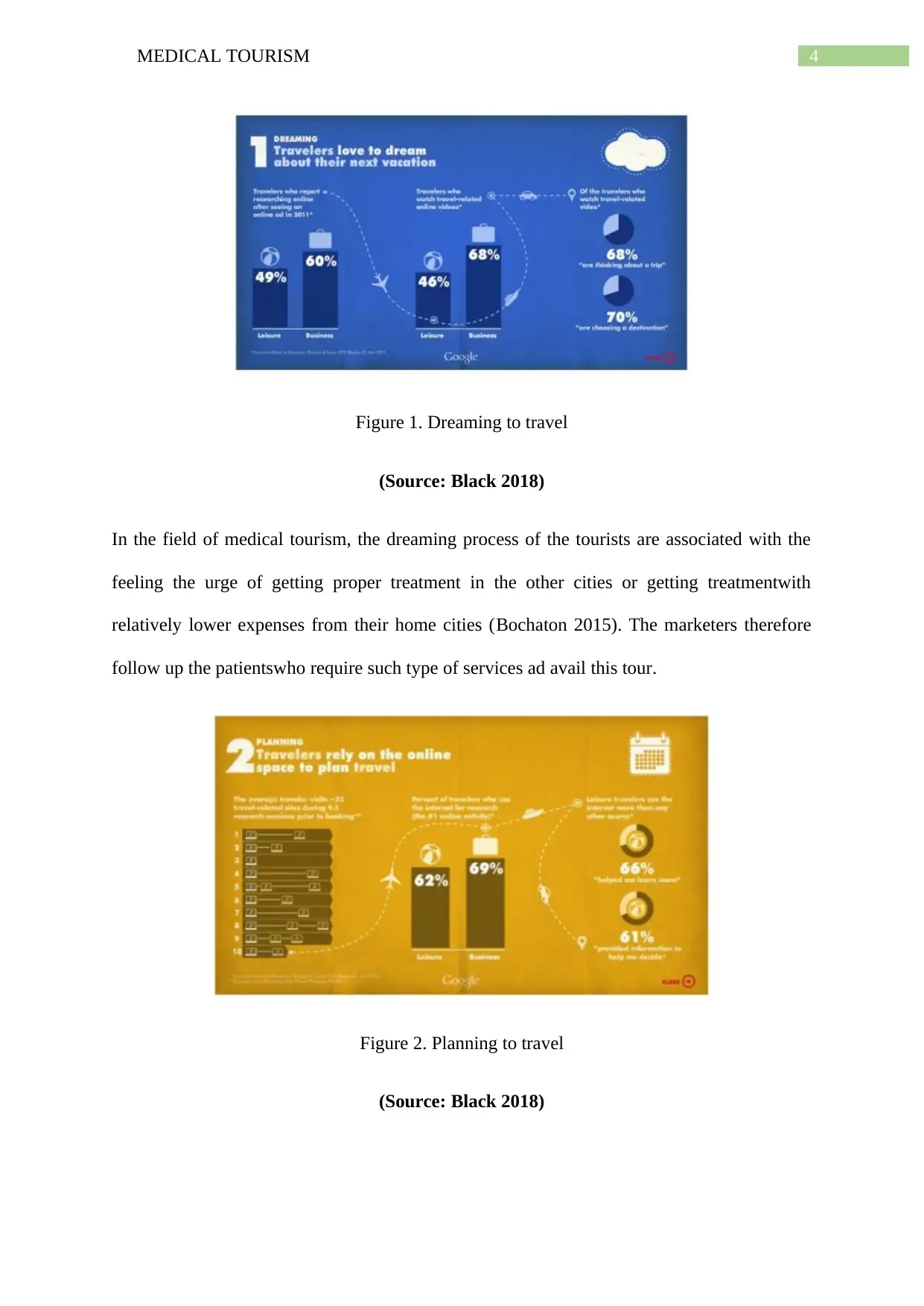
4MEDICAL TOURISM
Figure 1. Dreaming to travel
(Source: Black 2018)
In the field of medical tourism, the dreaming process of the tourists are associated with the
feeling the urge of getting proper treatment in the other cities or getting treatmentwith
relatively lower expenses from their home cities (Bochaton 2015). The marketers therefore
follow up the patientswho require such type of services ad avail this tour.
Figure 2. Planning to travel
(Source: Black 2018)
Figure 1. Dreaming to travel
(Source: Black 2018)
In the field of medical tourism, the dreaming process of the tourists are associated with the
feeling the urge of getting proper treatment in the other cities or getting treatmentwith
relatively lower expenses from their home cities (Bochaton 2015). The marketers therefore
follow up the patientswho require such type of services ad avail this tour.
Figure 2. Planning to travel
(Source: Black 2018)
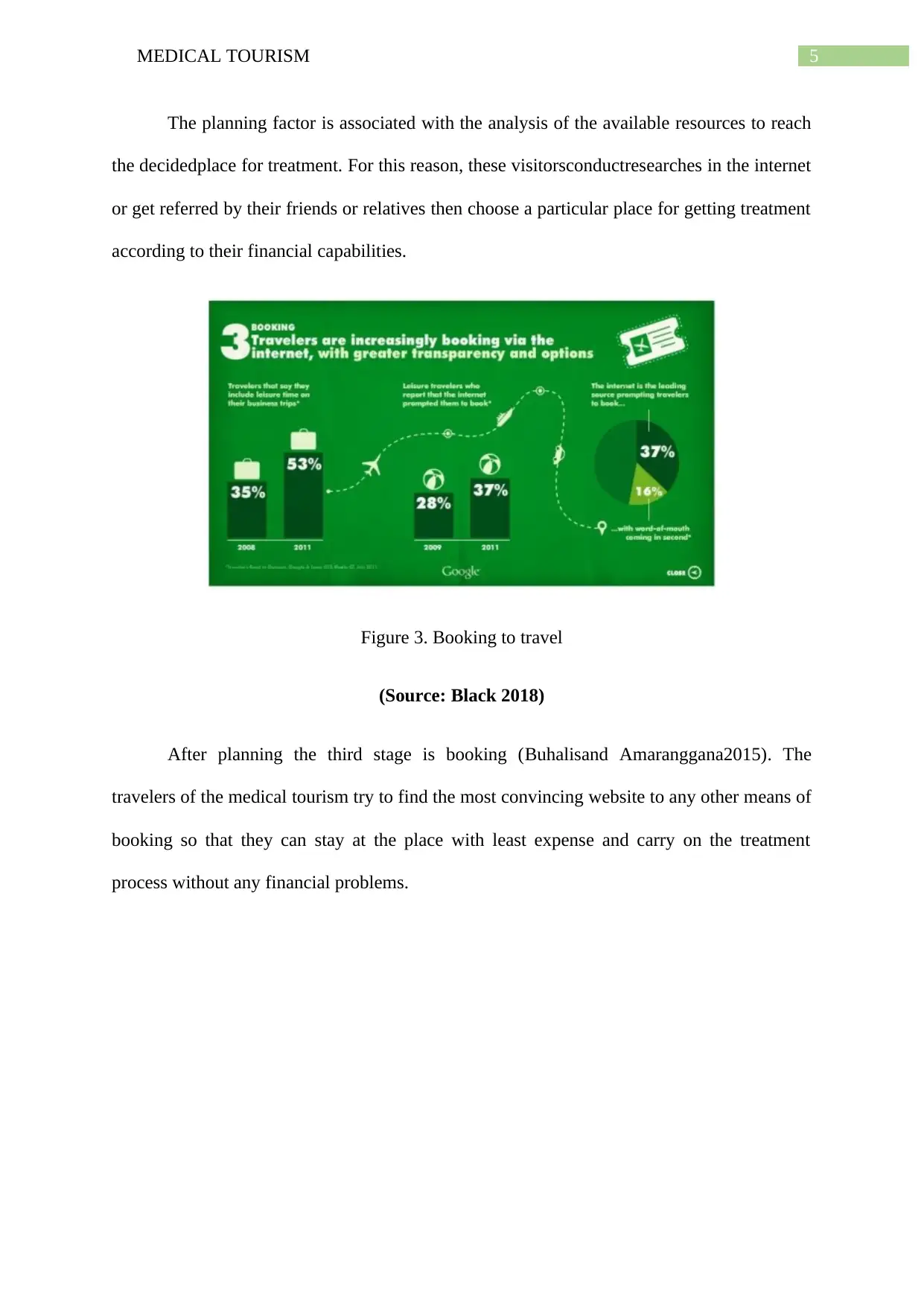
5MEDICAL TOURISM
The planning factor is associated with the analysis of the available resources to reach
the decidedplace for treatment. For this reason, these visitorsconductresearches in the internet
or get referred by their friends or relatives then choose a particular place for getting treatment
according to their financial capabilities.
Figure 3. Booking to travel
(Source: Black 2018)
After planning the third stage is booking (Buhalisand Amaranggana2015). The
travelers of the medical tourism try to find the most convincing website to any other means of
booking so that they can stay at the place with least expense and carry on the treatment
process without any financial problems.
The planning factor is associated with the analysis of the available resources to reach
the decidedplace for treatment. For this reason, these visitorsconductresearches in the internet
or get referred by their friends or relatives then choose a particular place for getting treatment
according to their financial capabilities.
Figure 3. Booking to travel
(Source: Black 2018)
After planning the third stage is booking (Buhalisand Amaranggana2015). The
travelers of the medical tourism try to find the most convincing website to any other means of
booking so that they can stay at the place with least expense and carry on the treatment
process without any financial problems.
⊘ This is a preview!⊘
Do you want full access?
Subscribe today to unlock all pages.

Trusted by 1+ million students worldwide
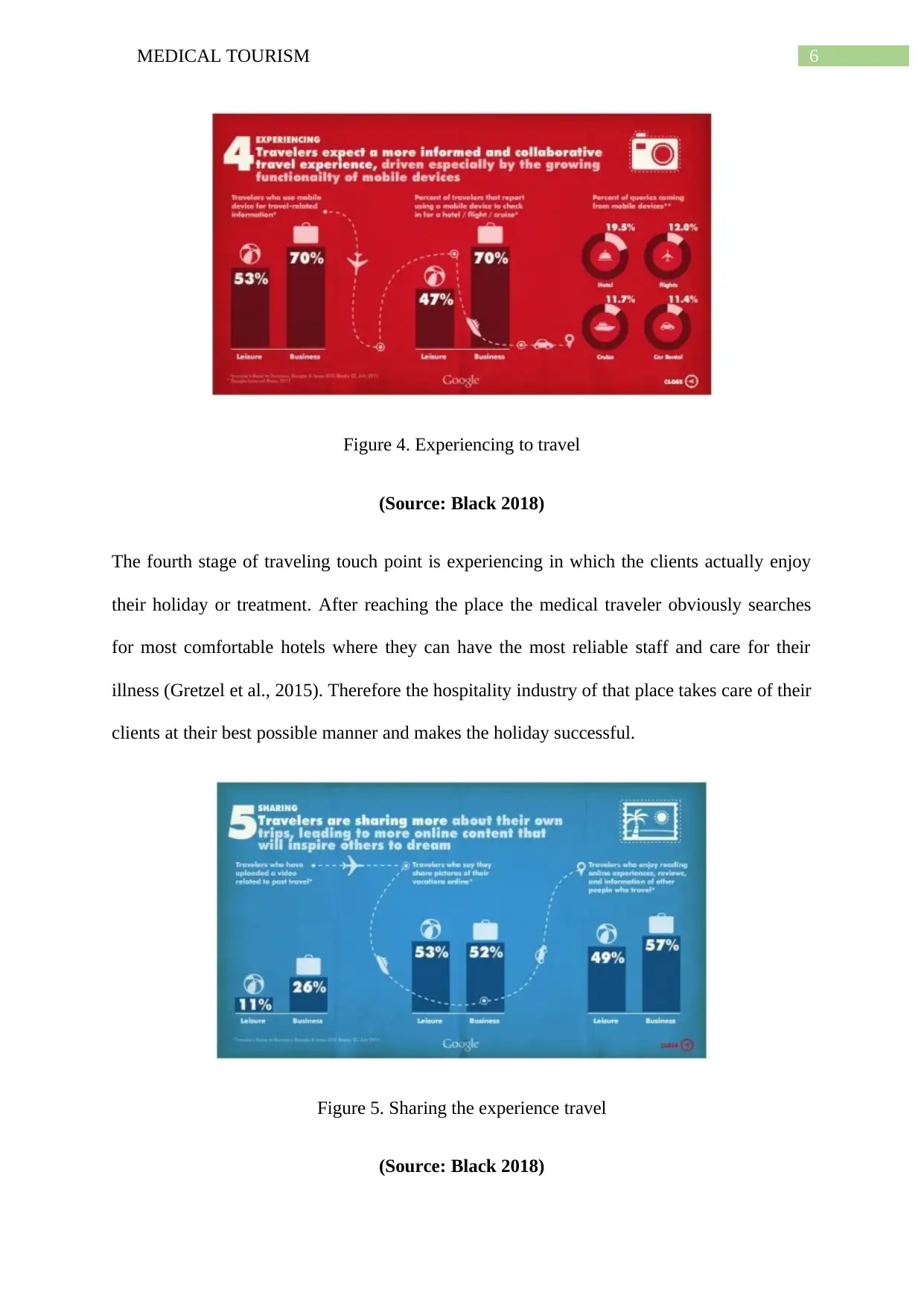
6MEDICAL TOURISM
Figure 4. Experiencing to travel
(Source: Black 2018)
The fourth stage of traveling touch point is experiencing in which the clients actually enjoy
their holiday or treatment. After reaching the place the medical traveler obviously searches
for most comfortable hotels where they can have the most reliable staff and care for their
illness (Gretzel et al., 2015). Therefore the hospitality industry of that place takes care of their
clients at their best possible manner and makes the holiday successful.
Figure 5. Sharing the experience travel
(Source: Black 2018)
Figure 4. Experiencing to travel
(Source: Black 2018)
The fourth stage of traveling touch point is experiencing in which the clients actually enjoy
their holiday or treatment. After reaching the place the medical traveler obviously searches
for most comfortable hotels where they can have the most reliable staff and care for their
illness (Gretzel et al., 2015). Therefore the hospitality industry of that place takes care of their
clients at their best possible manner and makes the holiday successful.
Figure 5. Sharing the experience travel
(Source: Black 2018)
Paraphrase This Document
Need a fresh take? Get an instant paraphrase of this document with our AI Paraphraser
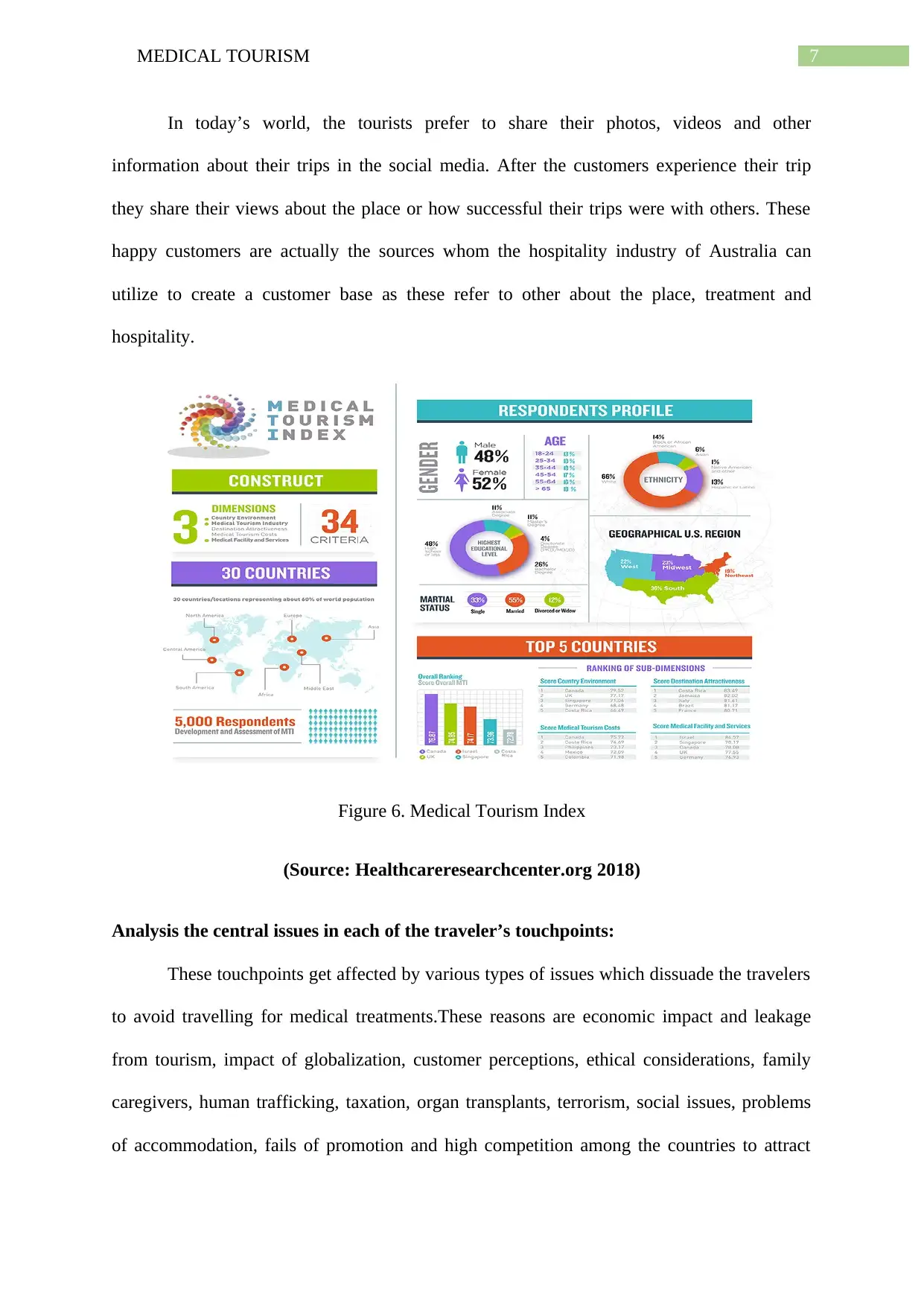
7MEDICAL TOURISM
In today’s world, the tourists prefer to share their photos, videos and other
information about their trips in the social media. After the customers experience their trip
they share their views about the place or how successful their trips were with others. These
happy customers are actually the sources whom the hospitality industry of Australia can
utilize to create a customer base as these refer to other about the place, treatment and
hospitality.
Figure 6. Medical Tourism Index
(Source: Healthcareresearchcenter.org 2018)
Analysis the central issues in each of the traveler’s touchpoints:
These touchpoints get affected by various types of issues which dissuade the travelers
to avoid travelling for medical treatments.These reasons are economic impact and leakage
from tourism, impact of globalization, customer perceptions, ethical considerations, family
caregivers, human trafficking, taxation, organ transplants, terrorism, social issues, problems
of accommodation, fails of promotion and high competition among the countries to attract
In today’s world, the tourists prefer to share their photos, videos and other
information about their trips in the social media. After the customers experience their trip
they share their views about the place or how successful their trips were with others. These
happy customers are actually the sources whom the hospitality industry of Australia can
utilize to create a customer base as these refer to other about the place, treatment and
hospitality.
Figure 6. Medical Tourism Index
(Source: Healthcareresearchcenter.org 2018)
Analysis the central issues in each of the traveler’s touchpoints:
These touchpoints get affected by various types of issues which dissuade the travelers
to avoid travelling for medical treatments.These reasons are economic impact and leakage
from tourism, impact of globalization, customer perceptions, ethical considerations, family
caregivers, human trafficking, taxation, organ transplants, terrorism, social issues, problems
of accommodation, fails of promotion and high competition among the countries to attract
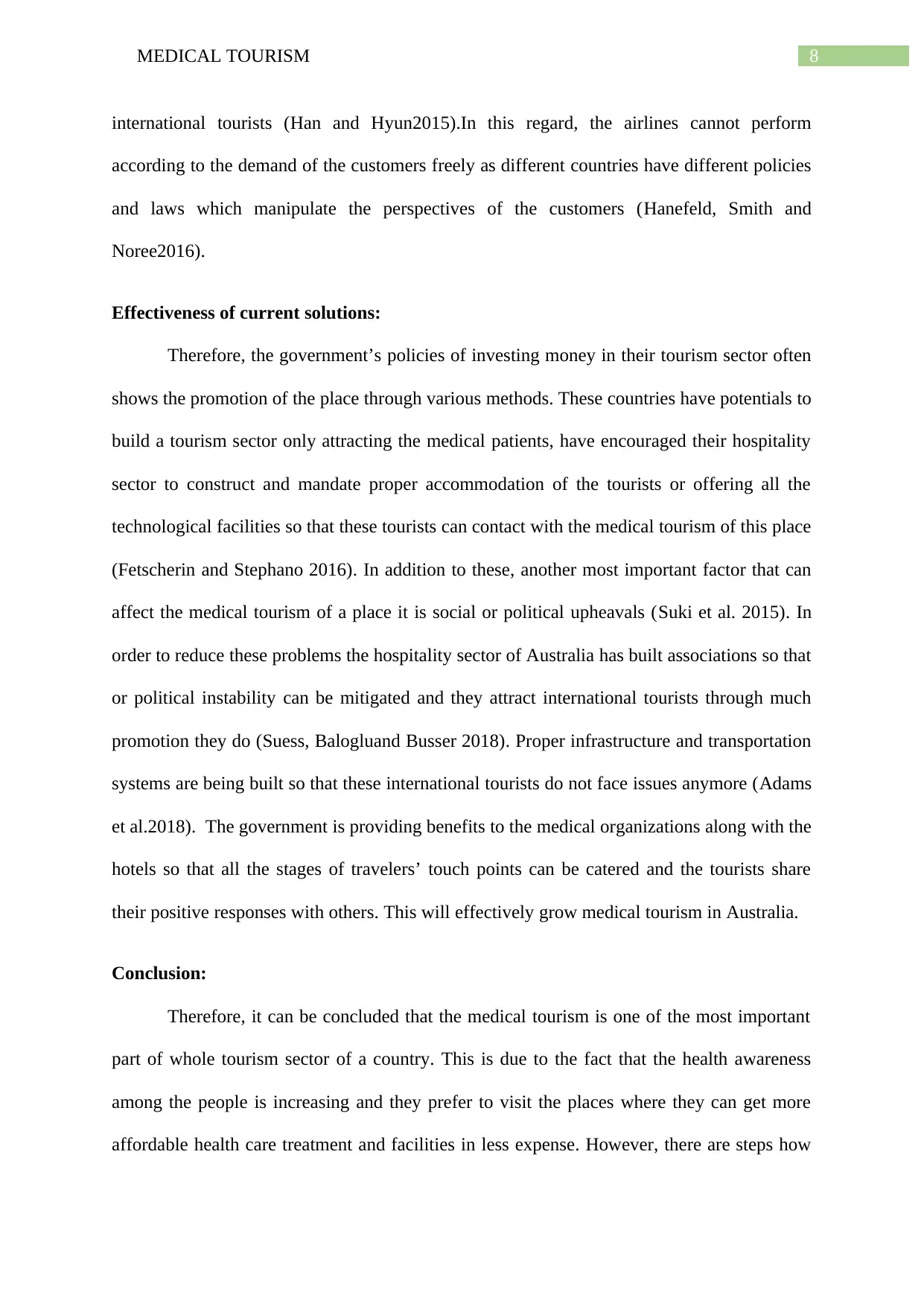
8MEDICAL TOURISM
international tourists (Han and Hyun2015).In this regard, the airlines cannot perform
according to the demand of the customers freely as different countries have different policies
and laws which manipulate the perspectives of the customers (Hanefeld, Smith and
Noree2016).
Effectiveness of current solutions:
Therefore, the government’s policies of investing money in their tourism sector often
shows the promotion of the place through various methods. These countries have potentials to
build a tourism sector only attracting the medical patients, have encouraged their hospitality
sector to construct and mandate proper accommodation of the tourists or offering all the
technological facilities so that these tourists can contact with the medical tourism of this place
(Fetscherin and Stephano 2016). In addition to these, another most important factor that can
affect the medical tourism of a place it is social or political upheavals (Suki et al. 2015). In
order to reduce these problems the hospitality sector of Australia has built associations so that
or political instability can be mitigated and they attract international tourists through much
promotion they do (Suess, Balogluand Busser 2018). Proper infrastructure and transportation
systems are being built so that these international tourists do not face issues anymore (Adams
et al.2018). The government is providing benefits to the medical organizations along with the
hotels so that all the stages of travelers’ touch points can be catered and the tourists share
their positive responses with others. This will effectively grow medical tourism in Australia.
Conclusion:
Therefore, it can be concluded that the medical tourism is one of the most important
part of whole tourism sector of a country. This is due to the fact that the health awareness
among the people is increasing and they prefer to visit the places where they can get more
affordable health care treatment and facilities in less expense. However, there are steps how
international tourists (Han and Hyun2015).In this regard, the airlines cannot perform
according to the demand of the customers freely as different countries have different policies
and laws which manipulate the perspectives of the customers (Hanefeld, Smith and
Noree2016).
Effectiveness of current solutions:
Therefore, the government’s policies of investing money in their tourism sector often
shows the promotion of the place through various methods. These countries have potentials to
build a tourism sector only attracting the medical patients, have encouraged their hospitality
sector to construct and mandate proper accommodation of the tourists or offering all the
technological facilities so that these tourists can contact with the medical tourism of this place
(Fetscherin and Stephano 2016). In addition to these, another most important factor that can
affect the medical tourism of a place it is social or political upheavals (Suki et al. 2015). In
order to reduce these problems the hospitality sector of Australia has built associations so that
or political instability can be mitigated and they attract international tourists through much
promotion they do (Suess, Balogluand Busser 2018). Proper infrastructure and transportation
systems are being built so that these international tourists do not face issues anymore (Adams
et al.2018). The government is providing benefits to the medical organizations along with the
hotels so that all the stages of travelers’ touch points can be catered and the tourists share
their positive responses with others. This will effectively grow medical tourism in Australia.
Conclusion:
Therefore, it can be concluded that the medical tourism is one of the most important
part of whole tourism sector of a country. This is due to the fact that the health awareness
among the people is increasing and they prefer to visit the places where they can get more
affordable health care treatment and facilities in less expense. However, there are steps how
⊘ This is a preview!⊘
Do you want full access?
Subscribe today to unlock all pages.

Trusted by 1+ million students worldwide
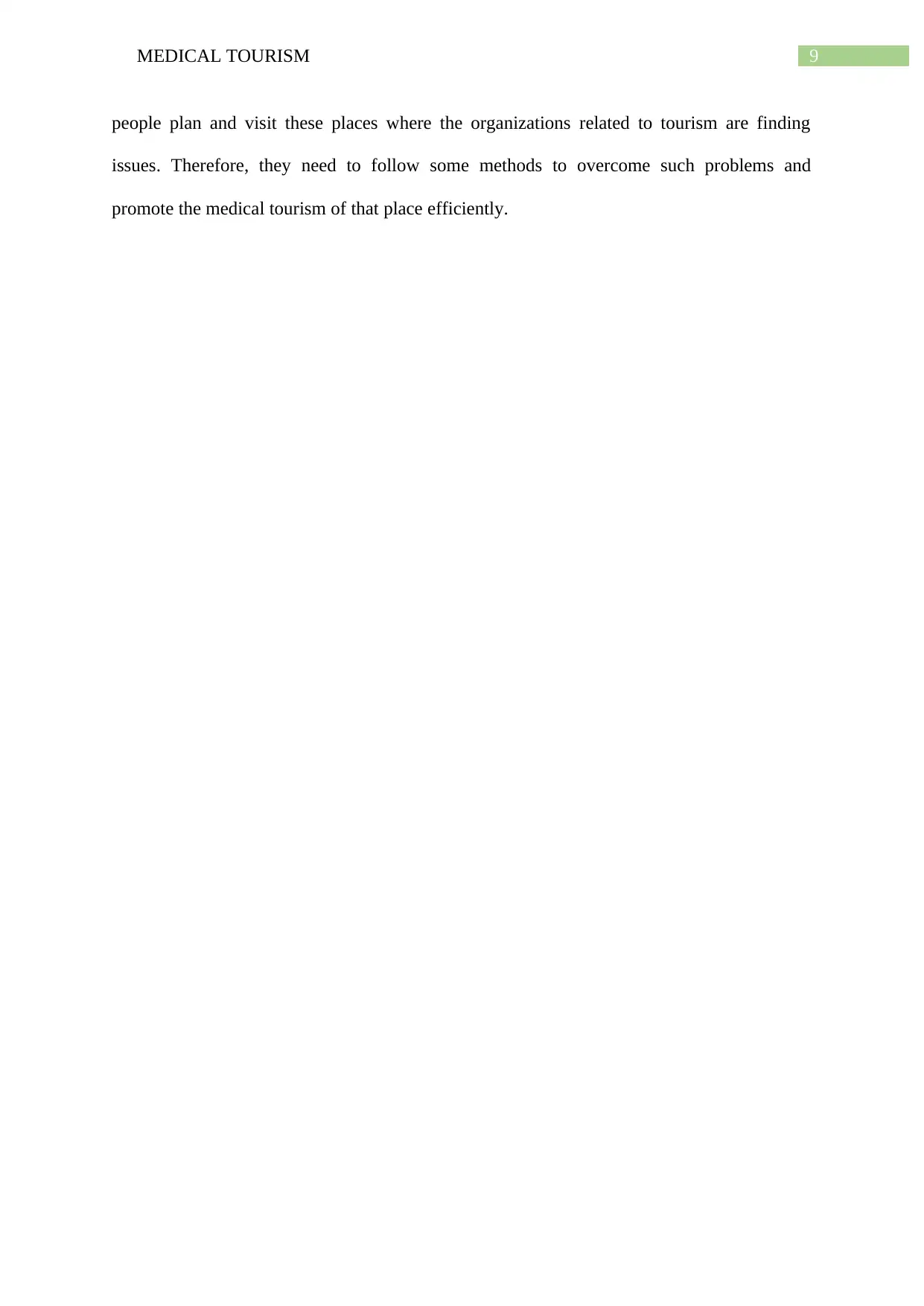
9MEDICAL TOURISM
people plan and visit these places where the organizations related to tourism are finding
issues. Therefore, they need to follow some methods to overcome such problems and
promote the medical tourism of that place efficiently.
people plan and visit these places where the organizations related to tourism are finding
issues. Therefore, they need to follow some methods to overcome such problems and
promote the medical tourism of that place efficiently.
Paraphrase This Document
Need a fresh take? Get an instant paraphrase of this document with our AI Paraphraser
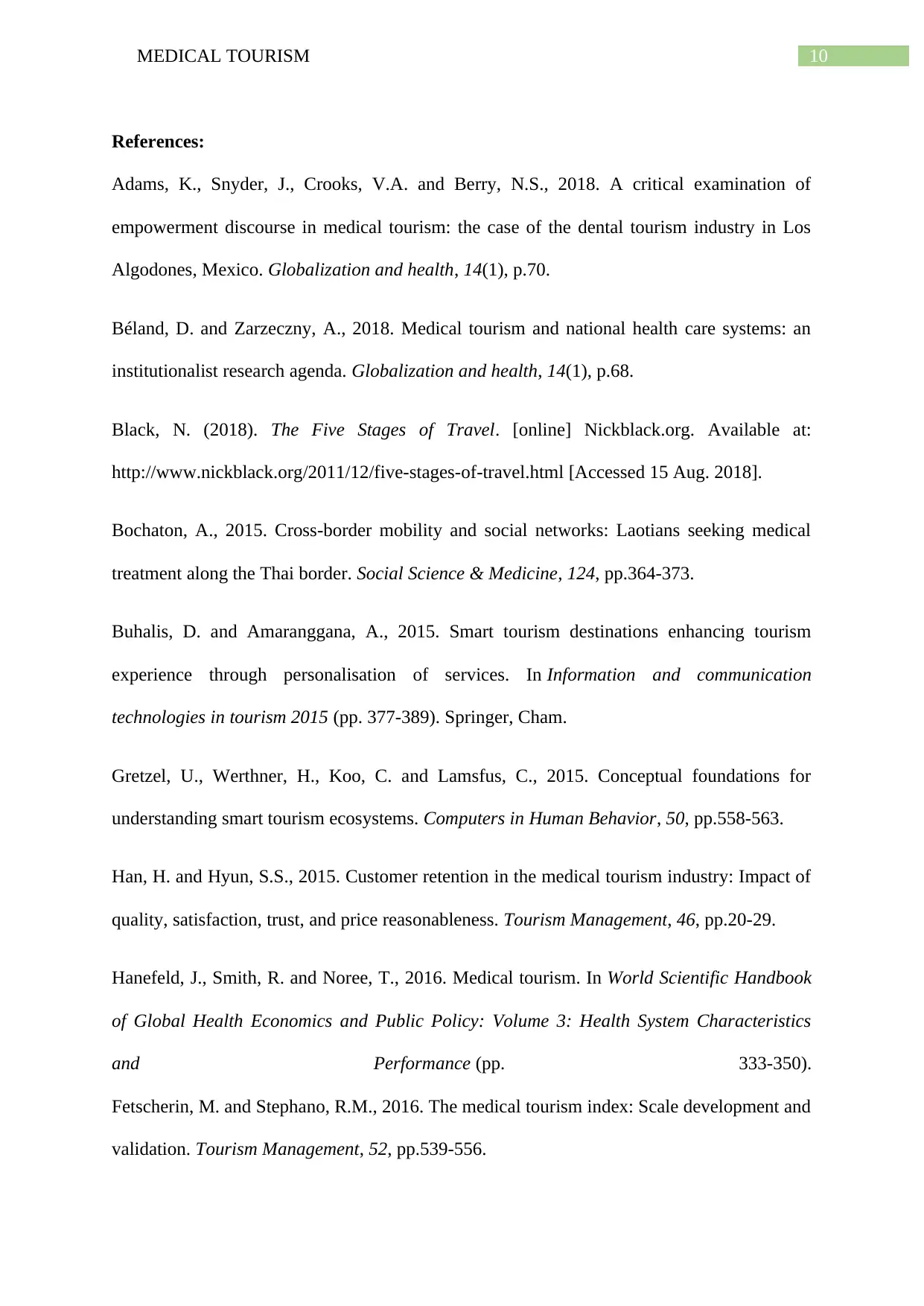
10MEDICAL TOURISM
References:
Adams, K., Snyder, J., Crooks, V.A. and Berry, N.S., 2018. A critical examination of
empowerment discourse in medical tourism: the case of the dental tourism industry in Los
Algodones, Mexico. Globalization and health, 14(1), p.70.
Béland, D. and Zarzeczny, A., 2018. Medical tourism and national health care systems: an
institutionalist research agenda. Globalization and health, 14(1), p.68.
Black, N. (2018). The Five Stages of Travel. [online] Nickblack.org. Available at:
http://www.nickblack.org/2011/12/five-stages-of-travel.html [Accessed 15 Aug. 2018].
Bochaton, A., 2015. Cross-border mobility and social networks: Laotians seeking medical
treatment along the Thai border. Social Science & Medicine, 124, pp.364-373.
Buhalis, D. and Amaranggana, A., 2015. Smart tourism destinations enhancing tourism
experience through personalisation of services. In Information and communication
technologies in tourism 2015 (pp. 377-389). Springer, Cham.
Gretzel, U., Werthner, H., Koo, C. and Lamsfus, C., 2015. Conceptual foundations for
understanding smart tourism ecosystems. Computers in Human Behavior, 50, pp.558-563.
Han, H. and Hyun, S.S., 2015. Customer retention in the medical tourism industry: Impact of
quality, satisfaction, trust, and price reasonableness. Tourism Management, 46, pp.20-29.
Hanefeld, J., Smith, R. and Noree, T., 2016. Medical tourism. In World Scientific Handbook
of Global Health Economics and Public Policy: Volume 3: Health System Characteristics
and Performance (pp. 333-350).
Fetscherin, M. and Stephano, R.M., 2016. The medical tourism index: Scale development and
validation. Tourism Management, 52, pp.539-556.
References:
Adams, K., Snyder, J., Crooks, V.A. and Berry, N.S., 2018. A critical examination of
empowerment discourse in medical tourism: the case of the dental tourism industry in Los
Algodones, Mexico. Globalization and health, 14(1), p.70.
Béland, D. and Zarzeczny, A., 2018. Medical tourism and national health care systems: an
institutionalist research agenda. Globalization and health, 14(1), p.68.
Black, N. (2018). The Five Stages of Travel. [online] Nickblack.org. Available at:
http://www.nickblack.org/2011/12/five-stages-of-travel.html [Accessed 15 Aug. 2018].
Bochaton, A., 2015. Cross-border mobility and social networks: Laotians seeking medical
treatment along the Thai border. Social Science & Medicine, 124, pp.364-373.
Buhalis, D. and Amaranggana, A., 2015. Smart tourism destinations enhancing tourism
experience through personalisation of services. In Information and communication
technologies in tourism 2015 (pp. 377-389). Springer, Cham.
Gretzel, U., Werthner, H., Koo, C. and Lamsfus, C., 2015. Conceptual foundations for
understanding smart tourism ecosystems. Computers in Human Behavior, 50, pp.558-563.
Han, H. and Hyun, S.S., 2015. Customer retention in the medical tourism industry: Impact of
quality, satisfaction, trust, and price reasonableness. Tourism Management, 46, pp.20-29.
Hanefeld, J., Smith, R. and Noree, T., 2016. Medical tourism. In World Scientific Handbook
of Global Health Economics and Public Policy: Volume 3: Health System Characteristics
and Performance (pp. 333-350).
Fetscherin, M. and Stephano, R.M., 2016. The medical tourism index: Scale development and
validation. Tourism Management, 52, pp.539-556.
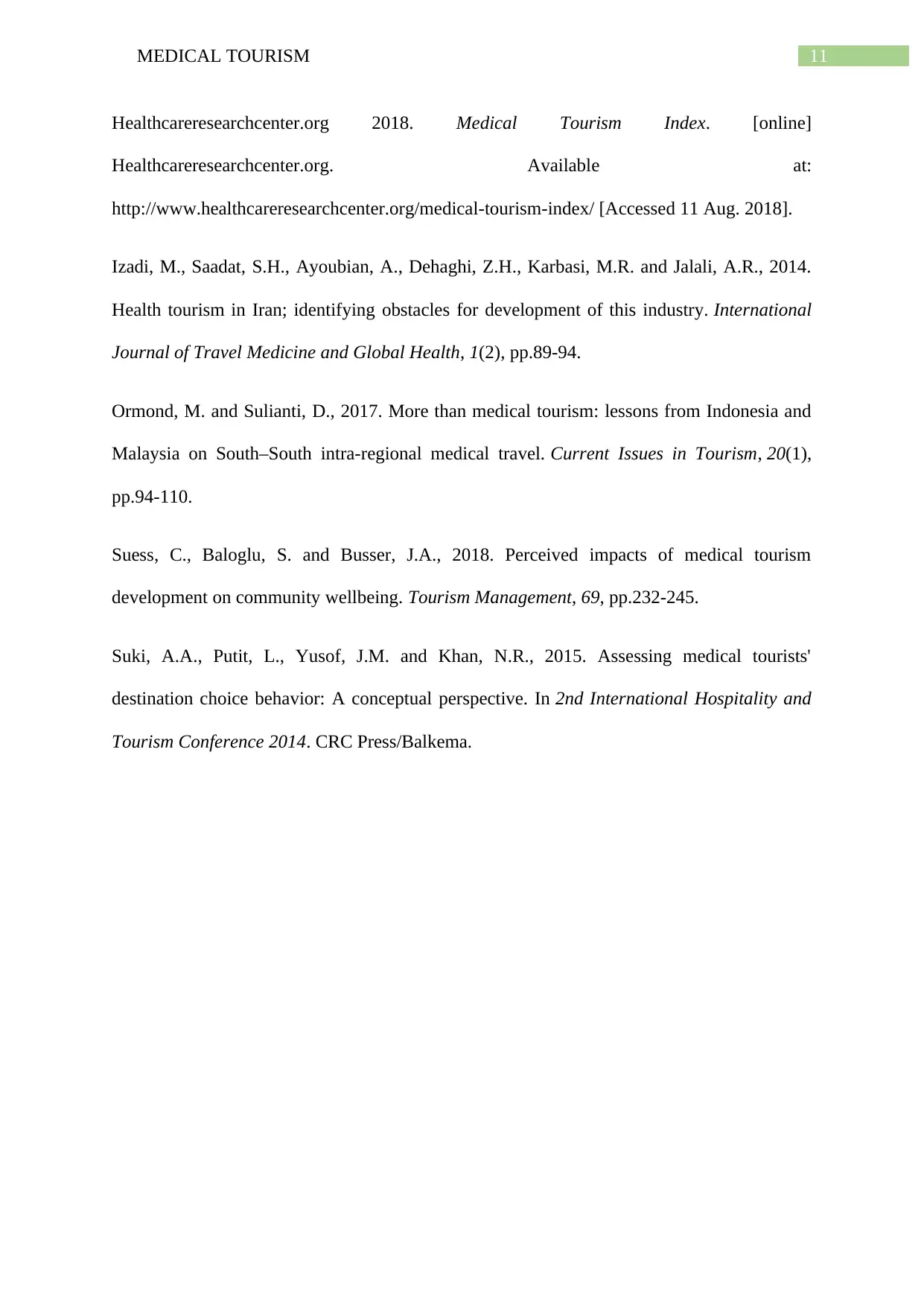
11MEDICAL TOURISM
Healthcareresearchcenter.org 2018. Medical Tourism Index. [online]
Healthcareresearchcenter.org. Available at:
http://www.healthcareresearchcenter.org/medical-tourism-index/ [Accessed 11 Aug. 2018].
Izadi, M., Saadat, S.H., Ayoubian, A., Dehaghi, Z.H., Karbasi, M.R. and Jalali, A.R., 2014.
Health tourism in Iran; identifying obstacles for development of this industry. International
Journal of Travel Medicine and Global Health, 1(2), pp.89-94.
Ormond, M. and Sulianti, D., 2017. More than medical tourism: lessons from Indonesia and
Malaysia on South–South intra-regional medical travel. Current Issues in Tourism, 20(1),
pp.94-110.
Suess, C., Baloglu, S. and Busser, J.A., 2018. Perceived impacts of medical tourism
development on community wellbeing. Tourism Management, 69, pp.232-245.
Suki, A.A., Putit, L., Yusof, J.M. and Khan, N.R., 2015. Assessing medical tourists'
destination choice behavior: A conceptual perspective. In 2nd International Hospitality and
Tourism Conference 2014. CRC Press/Balkema.
Healthcareresearchcenter.org 2018. Medical Tourism Index. [online]
Healthcareresearchcenter.org. Available at:
http://www.healthcareresearchcenter.org/medical-tourism-index/ [Accessed 11 Aug. 2018].
Izadi, M., Saadat, S.H., Ayoubian, A., Dehaghi, Z.H., Karbasi, M.R. and Jalali, A.R., 2014.
Health tourism in Iran; identifying obstacles for development of this industry. International
Journal of Travel Medicine and Global Health, 1(2), pp.89-94.
Ormond, M. and Sulianti, D., 2017. More than medical tourism: lessons from Indonesia and
Malaysia on South–South intra-regional medical travel. Current Issues in Tourism, 20(1),
pp.94-110.
Suess, C., Baloglu, S. and Busser, J.A., 2018. Perceived impacts of medical tourism
development on community wellbeing. Tourism Management, 69, pp.232-245.
Suki, A.A., Putit, L., Yusof, J.M. and Khan, N.R., 2015. Assessing medical tourists'
destination choice behavior: A conceptual perspective. In 2nd International Hospitality and
Tourism Conference 2014. CRC Press/Balkema.
⊘ This is a preview!⊘
Do you want full access?
Subscribe today to unlock all pages.

Trusted by 1+ million students worldwide
1 out of 12
Related Documents
Your All-in-One AI-Powered Toolkit for Academic Success.
+13062052269
info@desklib.com
Available 24*7 on WhatsApp / Email
![[object Object]](/_next/static/media/star-bottom.7253800d.svg)
Unlock your academic potential
Copyright © 2020–2025 A2Z Services. All Rights Reserved. Developed and managed by ZUCOL.





